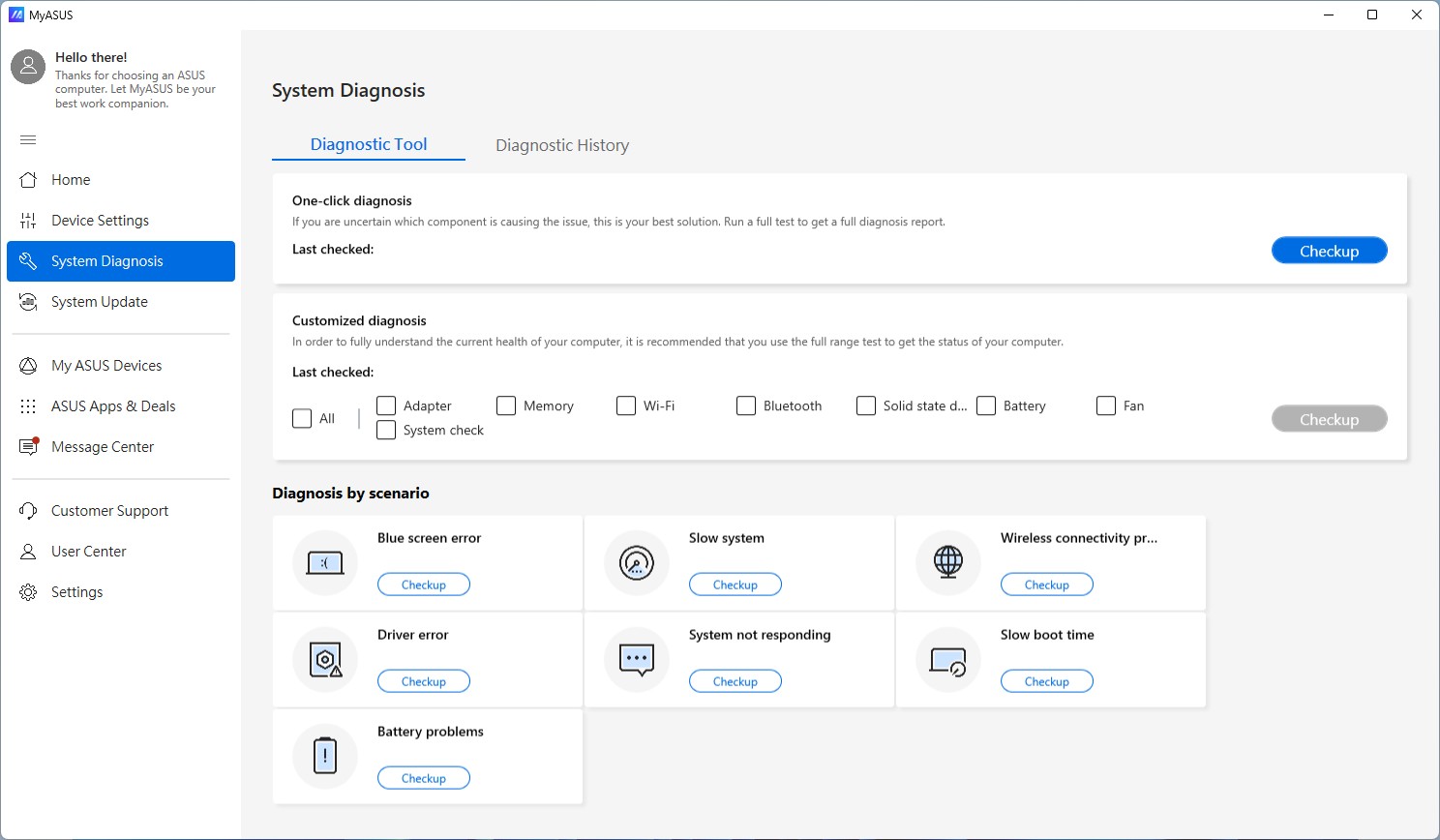Maintaining peak performance for your PC is crucial, whether you’re using it for intensive tasks or everyday use. Just like regular check-ups are vital for your car, System Diagnosis is essential for your computer’s health. ASUS understands this need and offers a powerful tool called MyASUS System Diagnosis to help you proactively manage your PC’s well-being. This built-in utility allows you to quickly identify potential issues, troubleshoot problems, and ensure your system runs smoothly.
MyASUS System Diagnosis is designed with user-friendliness in mind, offering both novice and experienced users the ability to perform comprehensive system checks. It categorizes common PC problems into easily recognizable scenarios, allowing you to pinpoint the area of concern and run targeted diagnostics. Instead of spending hours trying to figure out what’s wrong, MyASUS provides a streamlined approach to system diagnosis, saving you time and frustration.
Understanding the Power of System Diagnosis in MyASUS
MyASUS System Diagnosis offers two primary approaches to keep your PC in optimal condition:
-
One-Click Diagnosis: For users who want a quick and comprehensive overview of their system’s health, the One-Click Diagnosis is the perfect solution. This option performs a full system test, examining critical components such as the adapter, memory, Wi-Fi, Bluetooth, hard drives (HDD and SSD), battery, fan, and overall system functionality. If you’re unsure where the problem lies, this is the ideal starting point for a complete system diagnosis.
-
Customized Diagnosis: For those who prefer a more targeted approach or want to regularly monitor specific components, the Customized Diagnosis option provides granular control. You can select individual hardware components to check, allowing you to focus on areas of concern or conduct routine hardware check-ups to ensure everything is functioning correctly. This is particularly useful for proactive system maintenance and in-depth hardware analysis.
Beyond these general options, MyASUS System Diagnosis also excels in scenario-based diagnostics. This feature recognizes that PC problems often manifest in specific ways. Instead of generic tests, MyASUS offers tailored diagnostic paths for common issues, making the system diagnosis process more intuitive and effective. Let’s explore these scenarios in detail:
Scenario-Based System Diagnosis for Common PC Issues
MyASUS System Diagnosis anticipates the problems you might encounter and provides specific check-ups to address them:
-
Blue Screen Error (BSOD): The dreaded Blue Screen of Death often indicates hardware or driver malfunctions. MyASUS helps diagnose the root cause by checking memory, hard drives, sector health, and device drivers. These targeted tests can quickly pinpoint whether a hardware component or a driver issue is triggering the BSOD, streamlining the troubleshooting process.
-
Slow System: A sluggish PC can significantly impact productivity. MyASUS identifies common culprits like insufficient memory, low hard disk space, excessive application usage, and even fan issues that can lead to overheating and performance throttling. By checking these areas, MyASUS helps you optimize your system for better speed and responsiveness.
-
Wireless Connectivity Problems: In today’s connected world, Wi-Fi issues can be disruptive. MyASUS diagnoses wireless connectivity by examining your wireless device, settings, and network connections. This helps differentiate between problems with your PC’s Wi-Fi adapter and external network issues, allowing for targeted troubleshooting.
-
Driver Error: Incorrect or outdated drivers are a frequent source of system instability and crashes. MyASUS includes a dedicated driver check to ensure your device drivers are correctly installed and up-to-date. This helps prevent driver-related conflicts and maintain system stability.
-
System Not Responding: Random crashes and freezes can be frustrating. MyASUS investigates potential causes such as hard drive issues, sector errors, and file system corruption. These checks help identify underlying hardware or software problems that could be causing your system to become unresponsive.
-
Slow Boot Time: Long startup times can be a sign of underlying issues. MyASUS analyzes factors that affect boot speed, including memory, hard drive performance, boot time checks, and task scheduler configurations. Identifying these bottlenecks allows you to optimize your system for faster start-up.
-
Battery Problems: Battery issues can range from charging problems to rapid drain. MyASUS provides a battery check to ensure your battery is functioning correctly. It’s important to also physically check your AC adapter connections as suggested by MyASUS to rule out external power supply issues.
It’s important to note that the specific check items available may vary slightly depending on your ASUS device model, ensuring the diagnostics are tailored to your hardware.
Step-by-Step Guide to Performing System Diagnosis with MyASUS
Running a system diagnosis with MyASUS is straightforward. Here’s a step-by-step guide to get you started:
-
Choose Your Diagnosis Type: Open the MyASUS app and navigate to the System Diagnosis section. You will be presented with options for One-click diagnosis, Customized diagnosis, and Diagnosis by scenario. Select the option that best suits your needs. For example, to perform a customized check, select Customized diagnosis and choose the specific items you want to examine.
-
Initiate the Checkup: After selecting your desired diagnosis type and items (if applicable), click the [Checkup] button to begin the system diagnosis process. The duration of the tests will vary depending on the components being checked, so allow sufficient time for the process to complete.
-
Review the Results: Once the diagnosis is complete, click the [Result] button to view the findings.
-
Understand Troubleshooting and Solutions: If any errors are detected during the system diagnosis, MyASUS will display the error items, provide troubleshooting suggestions, and offer possible approaches to resolve the problem. For hardware errors, you can often create a repair ticket directly from this page or re-run the test to confirm the issue. Remember to back up your BitLocker recovery key or disable BitLocker before performing Windows Updates, as suggested by MyASUS, to prevent potential recovery issues.
-
Access Diagnostic History: You can review past system diagnosis results by clicking on [the last diagnosis time]. This allows you to track your PC’s health over time and monitor for recurring issues.
-
Explore Diagnostic History and Recovery Options: The Diagnostic History section provides a comprehensive record of previous diagnoses. From this page, you also have access to important system recovery options like Reset my PC, Create a recovery drive, and links to ASUS Customer services for further assistance. MyASUS provides direct access to guides on PC restoration to help you through the recovery process if needed.
Frequently Asked Questions about MyASUS System Diagnosis
Q1: How do I find out which version of MyASUS I have installed?
A1: To check your MyASUS version, navigate to [Settings] in the left-hand menu, then select [About] at the top. The Current Version will be displayed, indicating the MyASUS version installed on your system.
Q2: Can I use MyASUS system diagnosis when my PC is in airplane mode?
A2: Yes, most system diagnosis tests in MyASUS can be performed in airplane mode. The exceptions are the Wi-Fi & Bluetooth tests within Customized diagnosis and the entire Wireless connectivity problems scenario, as these require active wireless connections to function.
Q3: How do I request a repair after running a hardware diagnostic in MyASUS?
A3: For detailed instructions on initiating a repair request after a hardware diagnostic, please refer to this guide: How to apply the repair request after doing Hardware Diagnostic on MyASUS.
Q4: Why are some MyASUS features missing in my app?
A4: If you downloaded MyASUS from the Microsoft Store, you might encounter a version with limited features, such as missing system diagnostics, software updates, or device settings. This typically occurs when your PC lacks the necessary ASUS System Control Interface driver or if the driver version is outdated. For more information and solutions, consult this article: MyASUS Partial Features Issue.
Conclusion: Proactive PC Care with System Diagnosis
MyASUS System Diagnosis provides a comprehensive and user-friendly approach to maintaining your PC’s health. By utilizing its one-click, customized, and scenario-based diagnostics, you can proactively identify and address potential issues, ensuring optimal performance and longevity for your ASUS device. Regular system diagnosis is a crucial step in preventative PC maintenance, saving you from unexpected downtime and costly repairs in the long run.
Experience the peace of mind that comes with knowing your PC is in top condition. Download MyASUS today and take control of your system’s health!
[

